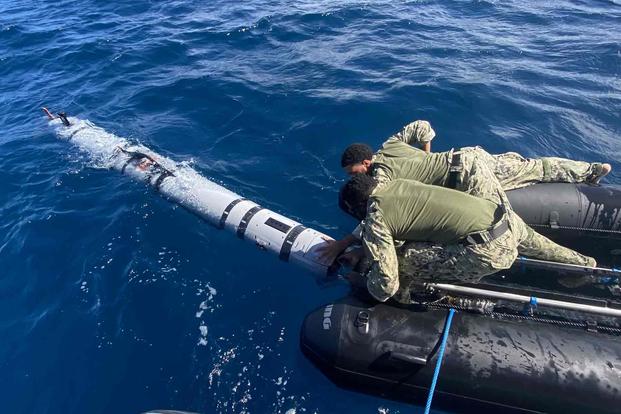The Navy has formally announced that it is creating a new robotics job -- referred to as a rating -- aimed specifically at operating drones and other autonomous vehicles as service leaders tout the technology as the future of warfare.
The new rating is called robotics warfare specialist and "will accelerate development of deep expertise in rapidly advancing autonomous technologies," the Navy said in an administrative message released Thursday.
The news comes just over a week after the Navy's top officer, Adm. Lisa Franchetti, previewed the move at a naval conference in San Diego.
Read Next: Vets Say Weight Loss Drugs Have Improved Their Health, But New Patients Are Out of Luck
The new robotics specialists will initially come from sailors who are already aerial or underwater drone operators, largely concentrated in the undersea and special warfare communities, according to the website for the new rating.
Lt. Meagan Morrison, a spokeswoman for the chief of naval personnel, told Military.com that sailors who have gone to schools for unmanned undersea vehicle operations of the MK 18 Mod 2 "Kingfish" undersea mine hunting drone, as well as the ScanEagle, Puma, Integrator and MQ-4 Triton aerial drones, will make up the initial cohort of new robotics warfare specialists.
The message released by the Navy noted that, while "all active-duty ratings are open for conversion" to the new job, "it is important to note that this will initially be a small and highly selective rating."
A fact sheet released by the Navy also noted that there will not be a corresponding officer specialty.
Last week, the commander of the Navy's Pacific Fleet, Adm. Sam Paparo, told a crowd at the WEST 2024 conference -- the same venue where Franchetti previewed the new rating -- that the service has "a very rich program of integrating" unmanned vehicles into its operations.
Paparo went on to say that the Navy has a "concept of unmanned and autonomous operations that will, in fact, augment and complement our ability to employ those capabilities when the unforgiving hour comes."
However, Paparo, who has been nominated to become the next commander of the Indo-Pacific theater, wouldn't elaborate further on what capabilities drones would bring to the fight, citing operational security.
Morrison said that the Navy expects to have around 400 sailors initially fill out the ranks of the new rating, abbreviated as RW, from those who already hold one of seven autonomous vehicle supervisory, operator or maintenance qualifications.
The first advancement exam will take place in September for E-5 and E-6 sailors, the rating's website said.
"The RW rating is a major milestone in our Navy's relentless march to achieve a truly hybrid fleet," the message announced.
Vice Adm. Rick Cheeseman, the chief of naval personnel, said in a social media post that one of the goals of the new job is to allow sailors "to work all aspects of tactical and operational employment of robotic systems as their primary duty, including preventative and corrective maintenance, testing, troubleshooting, networking information systems, configuration, data analysis, and utilizing technical documentation and test equipment."
Until now, these sailors would have been responsible for operating unmanned autonomous platforms as something outside their primary job in the Navy, thus hampering advancement opportunities.
The Navy's most public employment of drones has been its Middle East-based Task Force 59, which has operated a variety of airborne, sailing and underwater drones since 2021.
Although it was largely seen as a way for the Navy to experiment with the technology, last spring the service announced it was expanding those efforts to South America to help fight narcotics trafficking, among other missions.
Related: Despite Deadly Attack, US Military Still Grappling with How to Handle Enemy Drones












